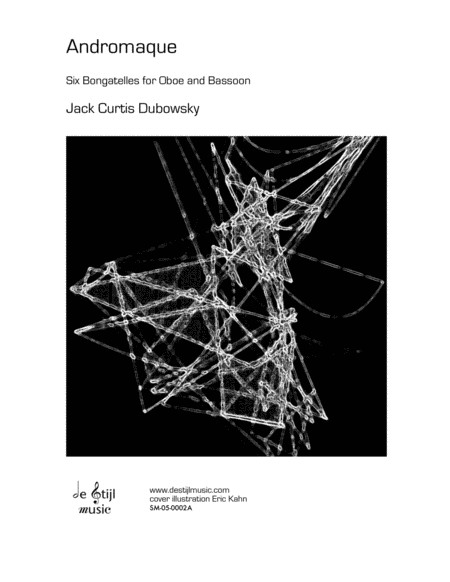Andromaque : Six Bongatelles (Oboe/Bassoon)$8.00 - See more - Buy online Lead time before shipment : 2 to 3 weeks By Jack Curtis Dubowsky. Duet. For Oboe, Bassoon. Contemporary. Sheet music. Composed 2005. Duration 12:00. Published by De Stijl Music Instrumentation : Oboe, Bassoon (duet)Publisher : Stijl Music"Bongatelles" is a pun in homage to Erik Satie's whimsical titles. Satie also found inspiration in Greek antiquity and French literature, most notably his Socrate. Jean Racine's (1639-1699) tragedy Andromaque (1667) inspired these duets. Racine took his characters from Greek and Roman stories and adapted or created new situations for them in accordance with baroque fascination with neo-classicism in literature. Andromaque is a love quadrangle in which all who love die or go insane. Only the prisoner-queen Andromaque, who is incapable of love, survives. Andromaque, icy cold, rejects amorous advances from her captor Phyrrus. She plots her survival, trying desperately to save her infant son Astyanax from the Greek ambassador Oreste who would have her Trojan line finished off for good. The baby Astyanax sleeps silently, unaware of the deadly drama surrounding him. Does he nap peacefully? Or does he dream, like his mother, of revenge for the death of his conquered father, the great Trojan warrior king Hector? Phyrrus awkwardly tries to sweet-talk his captive Andromaque into marriage. She rejects him until he becomes furious and threatens to kill her son Astyanax unless she agrees to wed. Phyrrus alternates between threats and cajoling. Hermione loves Phyrrus, who decides to marry Andromaque instead. She rejects her own suitor Oreste, until she vengefully has him kill Phyrrus. Oreste does her bidding, only to be rewarded by a final rejection. She accuses Oreste of being a murderous monster. When Hermione sees the body of Phyrrus, she kills herself. The Greek soldier and ambassador Oreste sailed to Epire to persuade King Phyrrus to kill or hand over the infant Astyanax, last of the line of Troy. Oreste is torn between duty and love for usury Hermione. Her broken promises and final rejection affect him profoundly. Oreste goes insane upon learning of her death.
|










